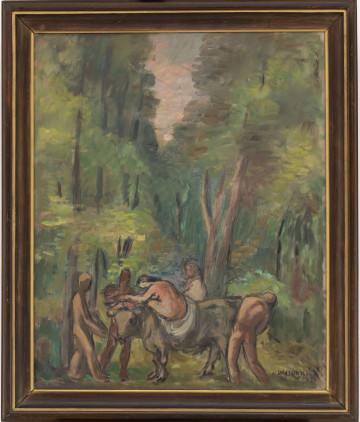
Still life with fruit
National Museum in Lublin
Part of the collection: Landscape
Landscape with a Windmill recalls the long tradition of landscape representations, known above all from the realistic depiction in Dutch painting. Czyżewski depicts a landscape with a centrally located construction of a windmill in the vicinity of residential buildings, typical of the Polish landscape. This view, however, is a pretext for his developing formal interests, consistently pursued in various phases of his work.
Czyżewski's work charted successive stages of modernity in Polish painting, which meant a departure from the historical and narrative patterns of 19th-century painting. As a co-founder of the Formist group (1917), he developed painting characterised by surprising and complicated formal arrangements, described by thick, black, expressive lines. Formism, syncretistically combining various trends of the beginning of the century – cubism, expressionism and futurism – experimented with conventions of representing reality as the fundamental problem of the ‘new art’, at the same time looking for native inspirations, for example in the tradition of Podhale or religious art. In this way, the beginnings of the Polish avant-garde were closely connected with the atmosphere of nativeness and the regaining of independence.
In the 1920s, Czyżewski's work evolved towards aestheticism, colour play, and a move towards colour positions. Maurice Denis's famous phrase, referring to the primacy of the arrangement of colours on canvas in relation to representation, became the motto of the varied explorations among Polish colourists gathered around Józef Pankiewicz in the Paris Committee and other artistic groups.
Pejzaż z wiatrakiem [Landscape with a Windmill] is a testimony to a mature style, in which the depicted world – the windmill, buildings, forest and clouds – is arranged in a uniform range of colours, combining warm and cold tones, which harmonise the whole surface of the painting and bring out individual elements of the painting scene. The native landscape translated into the play of colours and brush strokes became a universal model of the modernisation of Polish painting and the sublimation of aesthetic patterns. Czyżewski also treated his landscape in the opposite way, building a correspondence with the native past – the landscapes of Breslauer, Gerson, Brandt, and like them, saturating rural scenery with longing and intimacy.
Marcin Lachowski
Author / creator
Dimensions
cały obiekt: height: 65 cm, width: 55 cm
Object type
painting
Technique
oil technique
Material
canvas, oil-based paint
Creation time / dating
Creation / finding place
Owner
The National Museum in Lublin
Identification number
Location / status

National Museum in Lublin

National Museum in Lublin

1939
National Museum in Lublin
DISCOVER this TOPIC
Museum of King Jan III's Palace at Wilanów
DISCOVER this PATH
Educational path